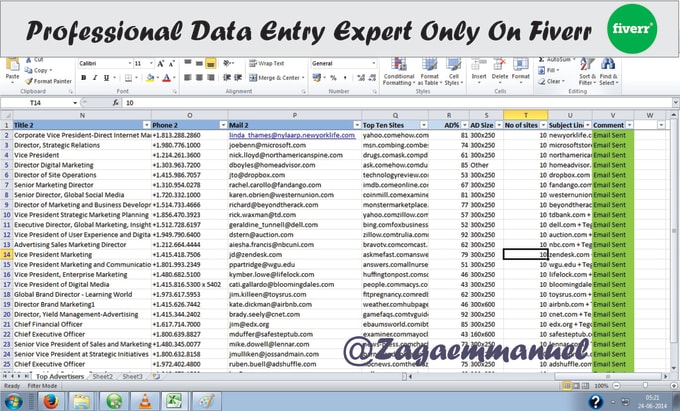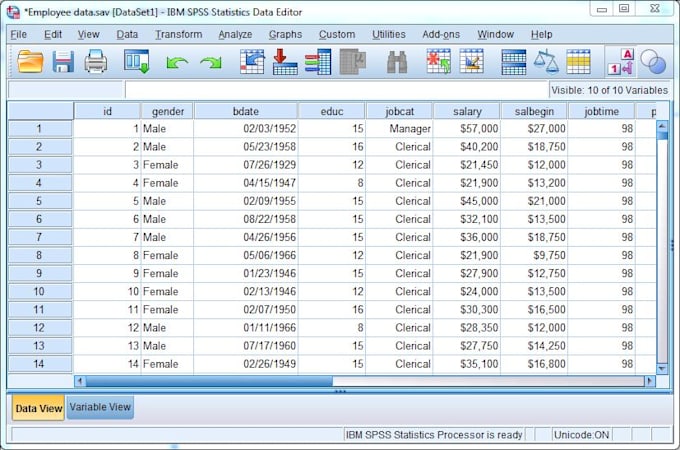Spss Data Entry Builder
FunctionUseExampleReturnsCompute difference between two dates in given time unitdatediff(date1,date2,'days')Standard numeric valueAdd / subtract numer of given time units to date variabledatesum(date,10,'days')Date valueExtract date component from date variablexdate.month(date)Standard numeric valueCreate date value from day, month, yeardate.dmy(19,3,2015)Date valueSPSS DATEDIFF FunctionSPSS DATEDIFF returns the number of time units(such as hours, days or years) between two date values.For instance, how many days ago did our respondents enter the hospital? We'll answer that by subtracting entrydate from the current date. The below does just that. Create current date as new variable in data.compute today = $time.execute.2.
Show current date in date format.formats today(edate10).3. Computecompute daysago = datediff(today,entrydate,'days').execute.4. Don't show any decimal places.formats daysago(f4). ResultSimple as that. Just one thing to keep in mind is that DATEDIFF (rounds down) its outcome values.
So 2 years and 363 days are returned as 2 years and 0 days if years are chosen as the time unit.If you don't want that, extract the number of days between 2 dates and divide them by 365.25 like we did in SPSS DATESUM FunctionSPSS DATESUM adds a number of time units to a date variable.For subtracting time, just enter a negative value.So say I want to contact respondents 3 months after they entered the hospital. However, 7 days before contacting them, they should be sent a notification.
The syntax below shows how to add both dates to our data. Add 3 months to entrydate for calculating contactdate.compute contactdate = datesum(entrydate,3,'months').execute.2.
Spss Data Entry Builder 4.0
Show time values as dates.formats contactdate(date11).3. Subtract 7 days from contactdate as notifydate.compute notifydate = datesum(contactdate,-7,'days').execute.4. Show time values as dates.formats notifydate(date11). Result SPSS XDATE FunctionSPSS XDATE extracts a date component(such as an hour, day or year) from a date.For example, the syntax below first extracts the year from entrydate and then the month. Extract year from date.compute year = xdate.year(entrydate).execute.2.
Extract month from date.compute month = xdate.month(entrydate).execute.3. Hide decimals.formats year month(f4).4. Apply value labels to month.value labels month 1 'January' 2 'February' 3 'March' 4 'April' 5 'May' 6 'June' 7 'July' 8 'August' 9 'September' 10 'October' 11 'November' 12 'December'. ResultAgain, it's as simple as that. An important warning, however, is thatXDATE.WEEK returns nonsensical week numbersas discussed in Unfortunately, there's no easy way to extract the that you probably want.
We built an tool for it but it somehow stopped working around SPSS version 24.Another thing to keep in mind is that there's no such thing as XDATE.DAY. Instead, use. XDATE.MDAY for the day of the month (1 through 31);.
XDATE.WKDAY for the day of the week (1 through 7 where 1 is Sunday, not Monday);. XDATE.JDAY for the day of the year (1 through 366).SPSS DATE.DMY FunctionSPSS DATE.DMY creates a date from its componentssuch as day, month and year.So say I want to know how many days before 20 January 2015 patients entered the hospital. I'll just create a new date variable (or -rather- constant) holding this date and subtract it from entrydate. Add startdate as January 20th., 2015 as new variable to data.compute startdate = date.dmy(20,1,2015).execute.2. Show startdate as date.formats startdate (date11).3. Compute days before start of data analysis.compute dayspassed = datediff(startdate,entrydate,'days').execute. ResultObviously, DMY means “day, month, year” so that's the order in which we'll enter these date components.
Now, in first instance, DATE.DMY results in a variable holding huge numbers. These are the numbers of seconds between the year 1582 and my actual data as explained in.These huge numbers can be shown as normal dates by setting the appropriate formats. For instance,today (DATE11).shows a date as “3-Sep-2018”. This is what we recommend because it's unambiguous which date this is. Pleaseavoid showing dates like “01-02-03”because this could mean. 1-Feb-2003 if its format is EDATE8 (European date),.
How To Enter Data In Spss
2-Jan-2003 if its format is ADATE8 (American date) and. 3-Feb-2001 if its format is SDATE8 (sortable date).SPSS Date ComparisonsWhen we compare two numbers, we can simply ask if one number is larger than the other.
The exact same, simple logic holds for date comparisons. However, there's one caveat: although we see “normal dates”, the underlying values (numbers of seconds since the year 1582) are used in date comparisons.This may sound daunting but the solution is simple: if we want to compare an SPSS date value with some comparison date, we simplyconvert the comparison date into an actual SPSS date.We just saw how to do so easily: fill in the date components into DATE.DMY. We'll demonstrate this with some examples.Say the hospital got a new CEO on February 20, 2014. We want to know if visits before this date are rated the same as visits after this date. We'll now select visits on and after February 20, 2014.
SPSS Date Comparison Example I. Compute newceo variable (all zeroes).compute ceo = 0.2. If entry date is at least February 20th., 2014, entry during new CEO.if (entrydate = date.dmy(20,2,2014)) ceo = 1.execute.3. Hide unnecessary decimals.formats ceo(f1).4. Add value labels to new variable.value labels ceo 0 'entrydate during old CEO' 1 'entrydate during new CEO'. Result Flagging visits that started on or after February 20, 2014.
SPSS Date Comparison Syntax Example IIThe Summer holidays in 2014 were from June 30, 2014 through August 24, 2014. How can we select visits during these holidays? The syntax below shows how to do so easily by using DATE.DMY within. This tutorial has 4 comments.


By on June 15th, 2017Hi Joy!At first glance, your syntax looks great. I can't troubleshoot it without seeing a sample of data, the result of your syntax and the desired result. If you could share a more tangible/replicable demonstration of the issue, that would help either me or anybody else who may assist.Until then, perhaps run all examples in our tutorial and see if one of those corresponds to what you're looking for.
Spss Tutorial Data Input
By Joy Bowles on June 15th, 2017Thanks Ruben. I have a question that I cannot find a solution to anywhere on the internet, so I'm hoping you can please help me.
Refine your search by using the following advanced search options. CriteriaUsageQuestions with keyword1 or keyword2keyword1 keyword2Questions with a mandatory word, e.g.
Keyword2keyword1 +keyword2Questions excluding a word, e.g. Keyword2keyword1 -keyword2Questions with keyword(s) and a specific tagkeyword1 tag1Questions with keyword(s) and either of two or more specific tagskeyword1 tag1 tag2To search for all posts by a user or all posts with a specific tag, start typing and choose from the suggestion list. Do not use a plus or minus sign with a tag, e.g., +tag1.